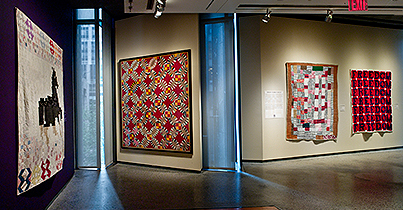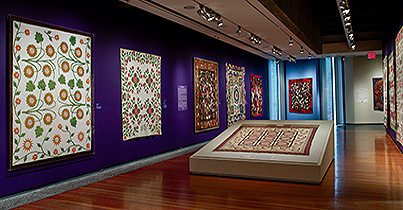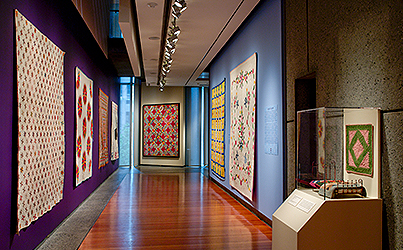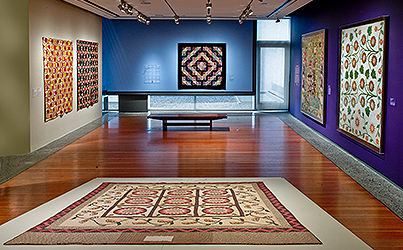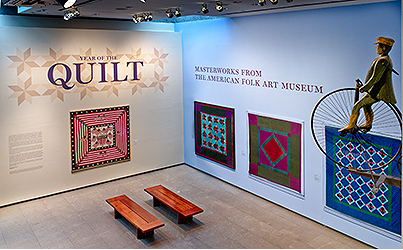CENTER STAR QUILT
Artist unidentified
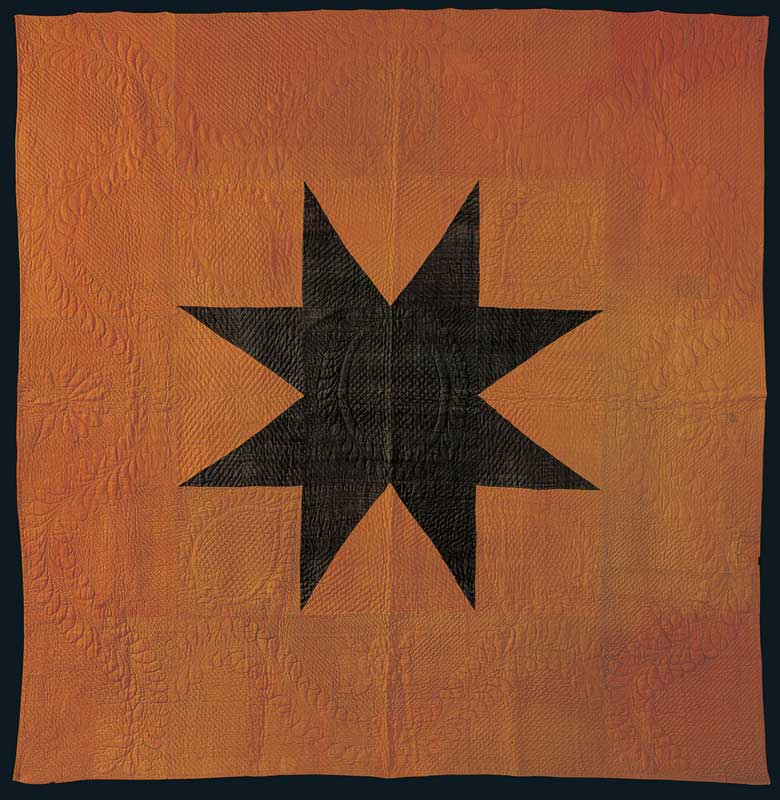

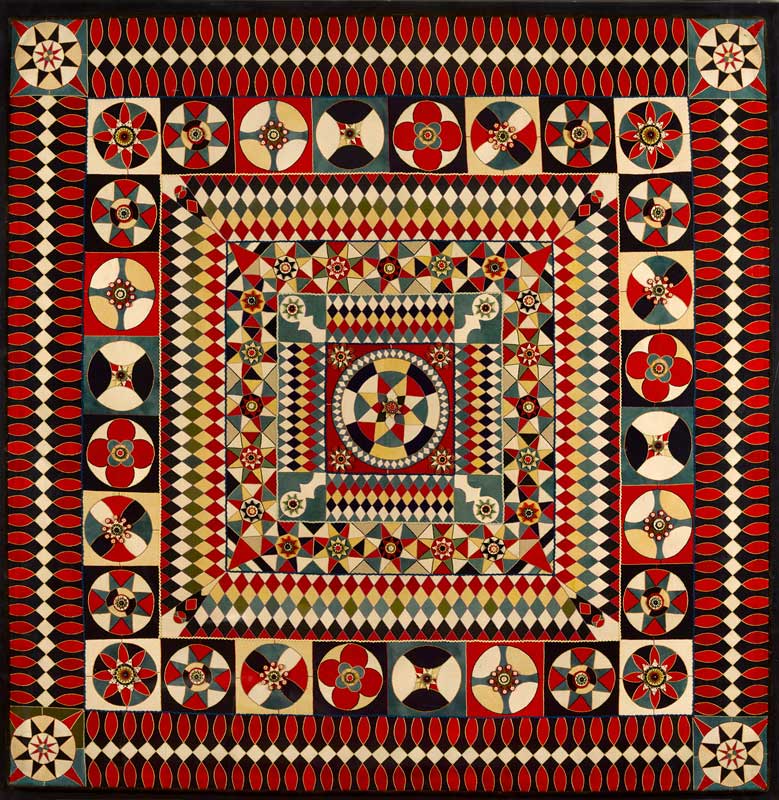
“Quilts: Masterworks from the American Folk Art Museum” anchors the Year of the Quilt, the museum’s celebration of a glorious American art form and the creative contributions of three centuries of talented women. Highlighting textile masterpieces in the collection, the exhibitions include recent gifts, bedcovers that have rarely been on view, and important cornerstones of the museum’s comprehensive quilt holdings. Given the rarity of the fabrics used in most of the museum’s historic quilts, the fine workmanship, and the quilts’ well preserved condition, it is clear that they are examples of “best” bedcovers, saved for use on special occasions or when company visited. During the late 19th and early 20th centuries, when quilts no longer needed to be made for mere warmth, quiltmakers used the art form to express their creativity within the confines of popular decorating trends. Most recently, contemporary fiber artists have taken the opportunity to transcend time and place, using the historical concept of a quilt as a starting point for their artistic, and often social and political, statements.
“Quilts: Masterworks from the American Folk Art Museum” is sponsored by The Magazine Antiques. Additional support for the exhibition is provided in part by the Leir Charitable Foundations in memory of Henry J. & Erna D. Leir; the Gerard C. Wertkin Exhibition Fund; the New York City Department of Cultural Affairs; and with public funds from the New York State Council on the Arts, celebrating 50 years of building strong, creative communities in New York State’s 62 counties.

Center Star Quilt
Artist unidentified
New England
1815–1825
Glazed wool
100 1/2 x 98 in.
American Folk Art Museum, gift of Cyril Irwin Nelson in honor of Robert Bishop, American Folk Art Museum director (1977–1991), 1986.13.1
For many years, late eighteenth- and early nineteenth-century whole-cloth wool quilts were mistakenly referred to as “linsey-woolseys.” Today, however, it is understood that these bedcovers were not made of a homespun combination of linen and wool, as that term implies, but rather were usually sewn entirely of wool. Often the wool that was selected for textiles such as this one was a professionally manufactured, glazed, worsted fabric known as “calimanco,” which probably was imported from England. This quilt also exhibits elaborate quilting motifs that are typical of late eighteenth- and early nineteenth-century calimanco and silk quilts. The fruit and floral motifs seen here are similar to Jacobean crewel embroidery designs and may have been adapted from the crewelwork bed hangings that were popular in eighteenth-century America.

Baltimore-Style Album Quilt Top
Artist unidentified
Baltimore; found in Uniontown, Pennsylvania
1845–1850
Cotton with wool embroidery
84 x 82 in.
American Folk Art Museum, gift of Altria Group, Inc., 2008.9.3
Photo by Gavin Ashworth
Probably the best-known sampler album quilts are those made in Baltimore between about 1845 and 1855. This quilt was made in the style attributed to “Designer 2” in the literature. Contrary to that label, however, quilts in the Designer 2 style probably were made by groups of women working together rather than an individual. Quilts in both the Designer 1 and Designer 2 groups have long been associated with makers who were members of the Protestant churches in Baltimore. The building in the center of this quilt is an interpretation of the Capitol building in Washington, D.C.

Soldier’s Quilt
Artist unidentified
Probably United States, Canada, or Great Britain
1854–1890
Wool melton
67 x 66 1/2 in.
American Folk Art Museum, gift of Altria Group, Inc., 2008.9.1
Photo by Gavin Ashworth
This textile belongs to a group of bedcovers that are also known as military quilts or, sometimes, Crimean quilts. Most of the known examples were found in Great Britain, where they were traditionally made from wool fabric used in the production of military uniforms. During the second half of the nineteenth century, soldiers were encouraged to take up sewing as a useful alternative to the less salubrious pursuits of drinking and gambling. Sewing was also used as a form of therapy for soldiers injured in conflict and recuperating in hospitals.
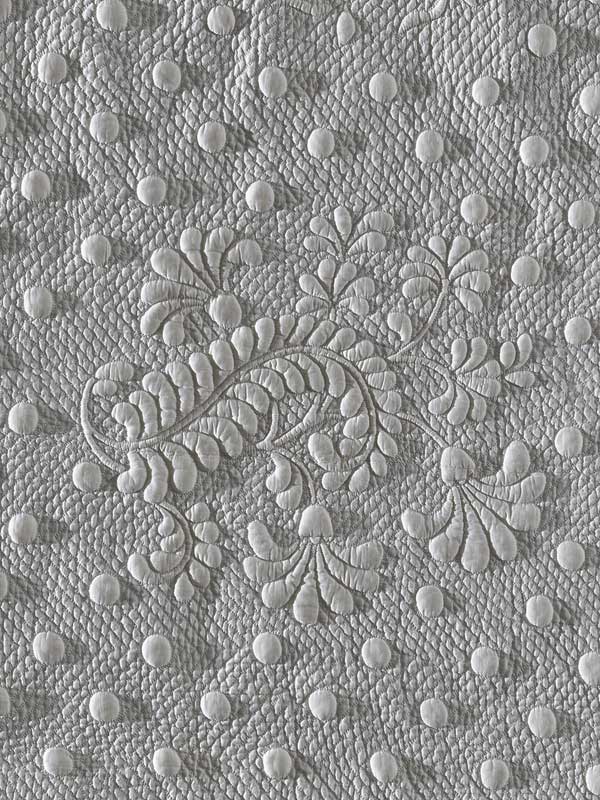
Cornucopia and Dots Whitework Quilt (detail)
Artist unidentified
United States
1800–1820
Cotton
95 x 89 in.
American Folk Art Museum, gift of Cyril Irwin Nelson, 2005.11.1
Photo by Gavin Ashworth
The raised motifs on this bedcover were created by cording and stuffing (a technique that is sometimes called trapunto in reference to a possible Italian origin for the tradition). This elaborate and time-consuming method involves quilting two layers of fabric together in a process termed “flat quilting,” which allows the seamstress to take minute stitches. Floral motifs, leaves, and other enclosed shapes are contained on all sides by quilting; the quiltmaker then pads the designs by working small bits of cotton through the coarse backing fabric.
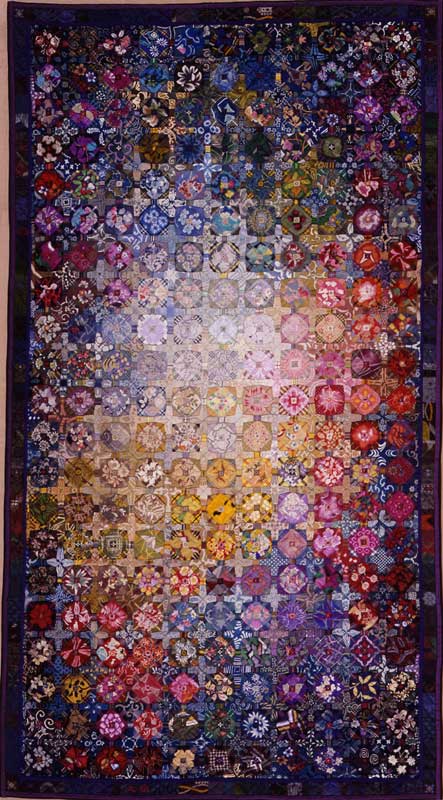
Yuen No Akari: Light From Far-Away Space
Setsuko Obi (b. 1942)
Tokyo, Japan
2001
Antique Japanese fabrics and hand-woven silk
78 3/4 x 48 in.
American Folk Art Museum, gift of the artist, 2001.30.1
Photo by Gavin Ashworth
Setsuko Obi learned quiltmaking while living in California in the 1970s. Since then, she has continued to quilt independently, specializing in works that employ antique Japanese fabrics. She particularly excels at quilts that emphasize color gradations and are made of many small pieces of fabric.

Whig Rose Quilt With Swag and Tassel Border
Artist unidentified
United States
1850–1860
Cotton
100 x 82 in.
American Folk Art Museum, gift of Irene Reichert in honor of Nathan Druet, 1993.1.2
Photo by Gavin Ashworth
One of the most popular floral appliqué patterns rendered in the red, green, and white color scheme was the Whig Rose, a design that is represented in the museum’s collection in a number of different variations. This quilt is distinguished by its “swag and tassel” border, evidence of the enduring popularity of the Greek Revival style in nineteenth-century America.
“Quilts: Masterworks from the American Folk Art Museum” is sponsored by The Magazine Antiques. Additional support for the exhibition is provided in part by the Leir Charitable Foundations in memory of Henry J. & Erna D. Leir; the Gerard C. Wertkin Exhibition Fund; the New York City Department of Cultural Affairs; and with public funds from the New York State Council on the Arts, celebrating 50 years of building strong, creative communities in New York State’s 62 counties.

